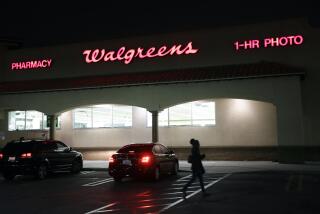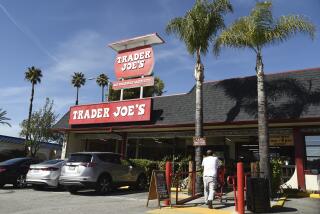Britain’s Tesco Plans to Enter U.S. Market With Chain of West Coast Express Stores
Another British invasion is coming -- and this time it’s targeting your neighborhood convenience store.
Supermarket giant Tesco, which has dominated Wal-Mart Stores Inc. and other competitors to maintain its standing as Britain’s largest retailer, announced Thursday that it would enter the U.S. market next year by opening convenience stores on the West Coast.
Tesco said it would spend as much as $435 million a year to build stores in the U.S. based on its Tesco Express format.
The company declined to release details about the number, location and branding of its planned stores, citing competitive concerns.
It said it expected to break even by the end of its second year in the U.S.
Tesco, which had previously focused its expansion plans on Europe and Asia, will be attempting to gain a foothold in an increasingly competitive $395-billion U.S. convenience store industry.
New players enter each year, analysts said, while existing segment leaders such as 7-Eleven continually retool their offerings in attempts to win market share and customer loyalty.
Tesco must hurdle obstacles that typically accompany a transatlantic move, including a lack of name recognition and different nuances in customer preference, analysts said.
That’s a particularly significant calculation for convenience stores, where the limited range of inventory leaves little room for error.
Another challenge: finding prime locations in markets that in many cases may already be built out. Nevertheless, said analyst Neil Saunders of Verdict Research in London, if Tesco finds promising locations and stocks its shelves with crowd pleasers, it can win over disaffected customers.
“The thing is, grocery customers are very fickle; they will change allegiance quite easily for something better,” he said. “If Tesco gets its proposition right, I think they can capture customers. But they have to get it right, and that’s the difficult bit.”
Chief Executive Terry Leahy said in a statement Thursday that Tesco had developed a format, drawing on years of market research here, that “we believe will be really popular with American consumers.” Tesco provided no details, though its Express stores in other markets primarily stock groceries.
Tesco’s announcement surprised some analysts, who noted that the company’s U.S. plans marked a shift from its emphasis on emerging markets. Counting its 2004 expansion in China, Tesco has stores in 12 markets outside Britain; the majority of its selling space is concentrated in its international markets.
Analyst Saunders said that although the announcement came “out of the blue,” the company’s westward gaze made sense given its ambition.
“They are looking to become increasingly global,” he said, “and you can’t really get global unless you have some sort of presence in the U.S.”
Carving out a distinctive identity will be important, said Nate Franke, an Orange County-based analyst with Deloitte & Touche.
“It’s a brand that is relatively unknown to the U.S. consumer, so I think their strategy has to be to create a niche, something that’s different that the consumer isn’t currently getting from the existing participants,” he said.
Tesco operates 2,647 stores, including 800 Express locations. The company, based in Cheshunt, England, reported 2005 profit of $3.5 billion, on sales of $64.6 billion.
More to Read
Inside the business of entertainment
The Wide Shot brings you news, analysis and insights on everything from streaming wars to production — and what it all means for the future.
You may occasionally receive promotional content from the Los Angeles Times.










